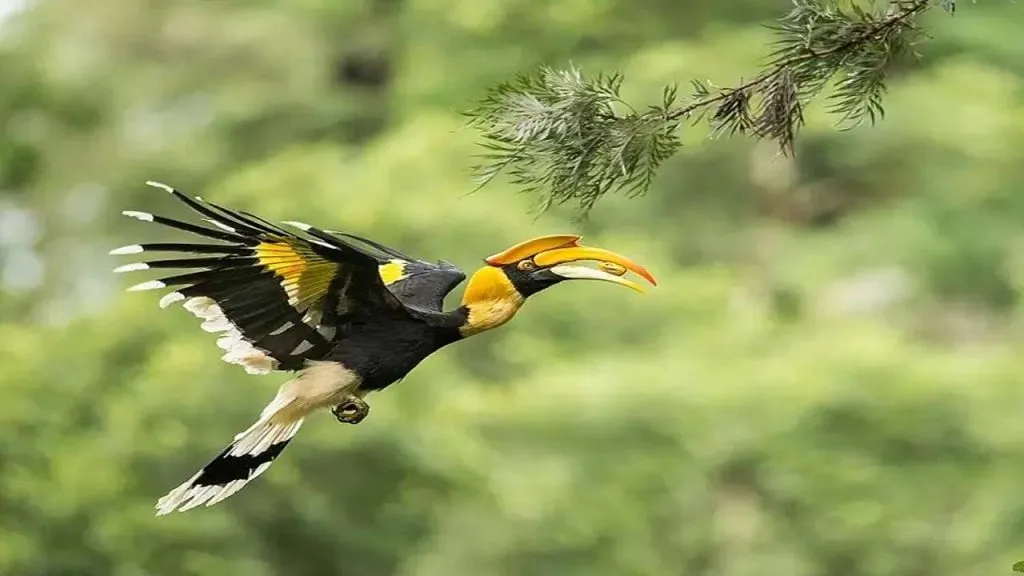As an Amazon Associate I earn from qualifying purchases.
Hornbills get their name from the special helmet-like structure on top of their bills.
This structure, made of a material called keratin (the same stuff in our nails and hair), serves two purposes.
It protects the hornbill’s head and also helps to make their distinctive honking calls louder.
These birds come in various sizes, from as small as a robin to as big as a goose.
The largest type called the southern ground hornbill, can weigh up to 9 pounds (4 kilograms) and stand about 2 feet (0.6 meters) tall.
Hornbills have long bills that curve downwards, and they look different depending on the species.
For example, the Oriental pied Hornbill is mostly white with black wings and tail.
Even though hornbills are famous for their cool looks and big bills, people are still curious about what they eat.
Different types of hornbills, like the Rhinoceros Hornbill, the Great Hornbill, and the Ground Hornbill, all have their favorite foods and ways of finding them.
In this article, we’ll talk about what hornbills like to eat, both when they’re out in the wild and when they’re kept in captivity.
We’ll look at the specific foods that Great Hornbills, Rhinoceros Hornbills, and other types of hornbills enjoy.
Plus, we’ll also find out how hornbills find their food.
What do Hornbills Eat: The Complete List of Food

Hornbills are birds that eat both plants and animals.
They enjoy eating fruits, insects, small mammals, reptiles, and sometimes even other birds.
What they eat depends on where they live and what food is around.
For many hornbill species, fruits are a major part of their diet, with figs being a particular favorite.
These fruits are not just tasty snacks; they also serve an important role in spreading seeds across their habitats.
After hornbills eat them, the seeds pass through their digestive system and get deposited in various areas, contributing to the growth of new plants and aiding in forest rejuvenation.
Hornbills really like to eat insects too. They’re good at finding beetles, grasshoppers, caterpillars, and ants.
Sometimes they catch them while they’re flying around, or they pick them off leaves and branches when they’re searching for food.
Some hornbills, especially those with a more predatory streak, have a taste for small reptiles like lizards and snakes.
With their robust bills, they skillfully capture and devour these prey items whole.
In addition to reptiles, certain hornbill species may also hunt small mammals like rodents and bats, particularly the larger hornbills that have the size and strength to handle such prey.
Although less common, some hornbill species may opportunistically feast on small birds, typically resorting to this when other food sources are scarce.
And let’s not forget about the invertebrates! Hornbills aren’t picky when it comes to snacks, so they might munch on snails and spiders, adding a protein-packed boost to their diet.
Here is a list of food that hornbills eat
- Rambutans
- Berries
- Drupes
- Beetles
- Ants
- Grasshoppers
- Seeds
- Nectar,
- Mice
- Squirrels
- Bats
- Frogs
- Tadpoles
What do Rhinoceros Hornbill Eat?
The Rhinoceros Hornbill mostly eats fruits, figs, insects, small reptiles, and occasionally small mammals such as rodents and birds.
Figs are especially popular among them and form a large part of their diet.
What do Great Hornbills Eat?
The Great Hornbill, also known as Buceros bicornis mainly eats fruits, but they also include insects and small animals in their diet.
They particularly enjoy large fruits such as figs, durians, and Malays, but they’re not picky and will also munch on insects, lizards, frogs, and even small mammals.
The huge casque, which is like a helmet on the male Great Hornbill’s head, is believed to indicate dominance and help them attract mates.
What do Ground Hornbills Eat?
Ground Hornbills, belonging to the Bucorvus species, mainly eat insects and meat, though they occasionally snack on fruits.
These birds spend the majority of their time on the ground in forests, where they hunt for insects such as beetles, termites, and grasshoppers.
They also have a taste for small mammals, reptiles, and amphibians. Unlike many other hornbills, ground hornbills prefer solitude and only gather with others during the breeding season.
Now that we’ve looked at what hornbills usually eat in the wild, let’s find out what do hornbills eat in captivity
What do Hornbills Eat in Captivity?
1. Fruit
In captivity, hornbills enjoy a lot of different fruits. They might get apples, pears, grapes, bananas, blueberries, papayas, figs, and more.
These fruits aren’t just tasty—they’re also packed with important vitamins and minerals that keep the hornbills healthy.
Plus, eating fruits gives them something fun and interesting to do!
2. Vegetables
In addition to fruits, vegetables are really important for making sure captive hornbills have a good, healthy diet.
They often get veggies like kale, spinach, lettuce, carrots, bell peppers, and squash.
These veggies provide important nutrients and keep the hornbills strong and healthy.
3. Insects
Hornbills need protein to stay healthy, and insects are a great source of it for them.
In captivity, they’re often given live insects to mimic how they would hunt in the wild.
This can include mealworms, crickets, grasshoppers, and other bugs that are good for the specific type of hornbill.
4. Meat
Some hornbills, especially the ones that like meat more, might get a bit of cooked chicken or turkey now and then.
But it’s important not to give them too much meat, just a little bit here and there, so they stay healthy and balanced.
5. Supplements
Sometimes, captive hornbills might need extra help getting all the vitamins and minerals they need.
So, their caretakers might give them special supplements recommended by bird doctors or nutrition experts.
These supplements make sure the hornbills stay healthy and strong by preventing any nutrient shortages.
6. Enrichment Items
Apart from their regular meals, captive hornbills can also get extra fun stuff to keep them entertained and engaged.
For example, their caretakers might hide live bugs like crickets or mealworms inside toys or puzzles.
This gives the hornbills a chance to practice their natural hunting skills and explore, which keeps them physically and mentally active and happy.
Caretakers who look after captive hornbills should team up with bird doctors and nutrition experts.
Together, they can create a diet that’s just right for each bird, considering their unique needs.
It’s crucial to keep an eye on what the hornbills eat and how they’re doing, making changes as needed to keep them healthy and happy for a long time in captivity.
How do Hornbills Find Their Food: The Hunting Method of Hornbills

Hornbills have lots of different ways to find food that match what they like to eat and what kind of hornbill they are.
Hornbills that eat fruit mostly use their eyes to find brightly colored fruits up in the trees.
Sometimes they follow other birds or hornbills to find where the fruits are.
On the other hand, hornbills that eat insects rely on their good hearing to listen for bugs hiding in the trees.
Some, like the wrinkled hornbill, even tap on trees with their beaks to scare insects out.
Both fruit and insect eaters are good at searching for food on tree branches, poking into cracks and looking under bark with their long beaks.
Fruit-eating hornbills are skilled at cracking open fruits to get to the yummy insides.
Some kinds of hornbills, like the lion-tailed macaque, work together with other animals like monkeys to find food.
They take advantage of the chaos caused by these animals to catch their prey.
One interesting thing is that hornbills’ beaks aren’t great for catching food at the very tip because their tongues are short.
So, they cleverly toss their food up in the air and catch it in their throats to eat it.
Overall, hornbills are smart about finding food in the rainforest, using a mix of seeing, hearing, and exploring to get what they need.
Interesting Facts About The Hornbills
1. Bird Architects: Hornbills are like expert builders.
When it’s time for them to have babies, they seal themselves inside holes in trees.
They use a mix of mud, poop, and food to make a strong cover.
They leave only a small hole so the dad can pass food to the mom and babies.
2. Different Bills: There are around 60 types of hornbills, and each has its special bill shape and size.
Some have long, curved bills, while others have shorter, stronger ones.
Their bills show what they like to eat and where they live.
3. Seed Spreaders: Hornbills help spread seeds by pooping them out as they move around.
This helps new plants grow in different places, which makes the forest diverse and healthy.
4. Strange Sounds: Famous for their spooky calls in the forest.
They make these sounds not just to talk but also to show they’re a family and to protect their home.
5. Cultural Symbols: In many places in Africa and Asia, hornbills are super important in stories, art, and special events.
They stand for things like strength, loyalty, and wisdom.
6. Big Birds: Some hornbills, like the Southern Ground Hornbill, are big.
Their wings can be longer than 6 feet, and they can weigh up to 13 pounds.
7. Old Birds: Hornbills are one of the oldest bird families. They’ve been around for more than 50 million years!
They haven’t changed much over time, so they’re like living history books.
8. True Love: Lots of hornbill couples stay together for a long time, maybe even forever.
They do special things together like feeding each other and flying in sync.
9. Protecting Hornbills: Even though hornbills are important, they’re in danger. People are cutting down their homes, hunting them, and selling them illegally.
People are working hard to save them and the places they live.
10. Great Flyers: Even though they’re big and have funny bills, hornbills are good at flying.
They have strong wings that help them glide smoothly through the forest to find food and places to have babies.
Conclusion
To sum up, hornbills play a big role in the forest. They’re seen as symbols of good fortune in various cultures and are vital to the ecosystem as a keystone species.
Watching these birds is captivating, and they contribute greatly to keeping the forest healthy.
FAQ’s:
No, hornbills typically don’t eat mice.
Their diet mainly consists of fruits, insects, small reptiles, and sometimes small mammals like rodents.
However, different species of hornbills may have slightly varied diets.
While hornbills primarily feed on fruits, insects, and small animals, they are not known to prey on other birds.
Their diet mainly consists of items found in their forest habitats, and they are not considered predatory towards other bird species.
Yes, hornbills are known to eat a variety of fruits.
Fruits make up a significant portion of their diet, and they play a crucial role in the dispersal of seeds through their droppings.
Hornbills’ diets can vary depending on the species and the availability of food in their habitat.
The lifespan of a hornbill varies depending on the species.
On average, they can live for around 20 to 30 years in the wild.
However, in captivity, where they may have access to better nutrition and healthcare, they can sometimes live longer, reaching up to 40 years or more.
Amazon and the Amazon logo are trademarks of Amazon.com, Inc, or its affiliates.

